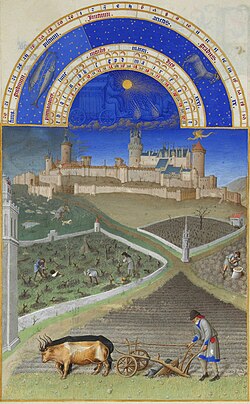History


The name of March comes from Martius , the first month of the earliest Roman calendar. It was named after Mars, the Roman god of war, and an ancestor of the Roman people through his sons Romulus and Remus. His month Martius was the beginning of the season for warfare, [2] and the festivals held in his honor during the month were mirrored by others in October, when the season for these activities came to a close. [3] Martius remained the first month of the Roman calendar year perhaps as late as 153 BC, [4] and several religious observances in the first half of the month were originally new year's celebrations. [5] Even in late antiquity, Roman mosaics picturing the months sometimes still placed March first. [6]
March 1 began the numbered year in Russia until the end of the 15th century. Great Britain and its colonies continued to use March 25 until 1752, when they finally adopted the Gregorian calendar (the fiscal year in the UK continues to begin on 6 April, initially identical to 25 March in the former Julian calendar). Many other cultures, for example in Iran, or Ethiopia, still celebrate the beginning of the New Year in March. [7]
March is the first month of spring in the Northern Hemisphere (North America, Europe, Asia and part of Africa) and the first month of fall or autumn in the Southern Hemisphere (South America, part of Africa, and Oceania).
Ancient Roman observances celebrated in March include Agonium Martiale, celebrated on March 1, March 14, and March 17, Matronalia, celebrated on March 1, Junonalia, celebrated on March 7, Equirria, celebrated on March 14, Mamuralia, celebrated on either March 14 or March 15, Hilaria on March 15 and then through March 22–28, Argei, celebrated on March 16–17, Liberalia and Bacchanalia, celebrated March 17, Quinquatria, celebrated March 19–23, and Tubilustrium, celebrated March 23. These dates do not correspond to the modern Gregorian calendar.


